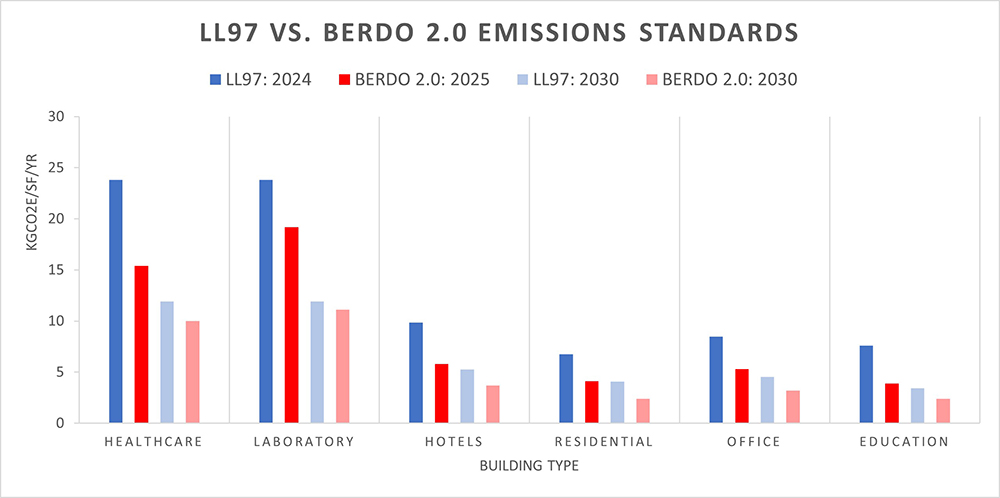
Greener skylines ahead: BERDO 2.0 and Local Law 97 - by Roselin Osser

AKF
Introduction: Rooting for the home team is no longer just for sports fans. Both Boston and New York City residents can take pride in impressive progress and continued climate action leadership over decades to come. NYC’s Local Law 97 (LL97) and Boston’s Building Emissions Reduction and Disclosure Ordinance 2.0 (BERDO 2.0) are groundbreaking new policies that set increasingly stringent, mandatory carbon allowances for all large buildings.
History and Motivation: Constituents of both cities are highly motivated to mitigate the disproportionate effect of climate change on vulnerable communities, improve city resiliency, and transition to a clean energy economy. Energy decarbonization will improve air quality and decrease flooding risk from climate change effects.
Both cities, as well as the states of Massachusetts and New York, have been among the earliest U.S. adopters of new construction green building standards. MA and NY have each created a more stringent “Stretch” code surpassing statewide code, adopted by Boston and NYC, in addition to other strict city requirements.
However, tough standards for new construction do not address climate emission of poorly performing older buildings. Both cities are now pioneering stringent existing building carbon standards to reach ambitious climate goals.
LL97 and BERDO 2.0
NYC has pledged to make an 80% reduction in greenhouse gas (GHG) emissions by 2050 compared to 2005 levels. In 2019, Local Law 97 (LL97) made NYC the first city in the world to put limits on all existing and new building carbon emissions, targeting buildings over 25,000 s/f. Specific area-weighted carbon thresholds by building type have been established for 2024 and 2030. Penalties are defined for exceeding carbon thresholds ($268/yr/metric ton of carbon). In addition to improving energy efficiency and installing renewable energy systems on site, thresholds can be met by purchasing approved renewable energy credits (RECs) or carbon offsets.
Similarly, Boston has committed to reaching net zero carbon emissions by 2050. In 2021, BERDO 2.0 set increasingly stringent carbon emissions caps for different building types every five years from 2025 to 2050. To comply, buildings may reduce energy use through energy efficiency measures, install renewable energy, purchase approved RECs, or make Alternative Compliance Payments ($234/yr/metric ton of carbon).
Building owners and operators can hit the ground running to meet LL97 and BERDO 2.0 targets because of the reporting requirements already in place. NYC’s LL84 has required public energy use reporting for buildings over 50,000 s/f since 2009 (reduced to 25,000 s/f by LL133 in 2016). Boston’s original BERDO ordinance (2013) has required public reporting of energy use for buildings over 35,000 s/f or greater than 35 residential units.

Emissions Standards: LL97 and BERDO 2.0 both set carbon emissions per unit area for a limited number of building categories. While use categories and units differ between the standards, a simplified comparison of several building types for the first two compliance periods is made above, using units of kg CO2e/sf/yr. To derive a building’s emissions to be compared to the standard for a building category such as “office,” total reported energy by type (such as electricity, central plant utilities, natural gas, or other fuels) is multiplied by referenced carbon emissions factors; the total is divided by building square footage. While Boston’s standards are set through 2050, NYC has not yet defined carbon limits after the 2030-2034 reporting period. As shown, stringent reductions are planned for both cities, but Boston is more stringent for the first two compliance periods.
Parallel Grid Electrification: Mandatory reductions in building energy use will work hand in hand with ambitious electric grid decarbonization targets. The utilities serving Boston have pledged net zero carbon by 2050. NY State’s Climate Act requires that the electric grid reach carbon neutrality by 2040. Utility steam generators are also undertaking decarbonization efforts. Both cities will require massive influxes of solar and wind power as well as many grid efficiency upgrades.
Looking Ahead: Standards for new construction continue to rise. A new ZNC (Zero Net Carbon) Building Emissions Performance Standard is in development for Boston, in parallel with a statewide “Specialized Opt-in” net zero code. NYC has recently enacted a ban on natural gas in most new construction (Local Law 154, 2021) while also planning a transition away from existing building natural gas use.
Boston and NYC have fundamentally reshaped the role of buildings in our environment and economy. These new policies set both cities on track for continued climate action leadership.
Roselin Osser, PE, BEMP, LEED AP BD+C is a senior engineer with AKF’s Energy + Performance team.